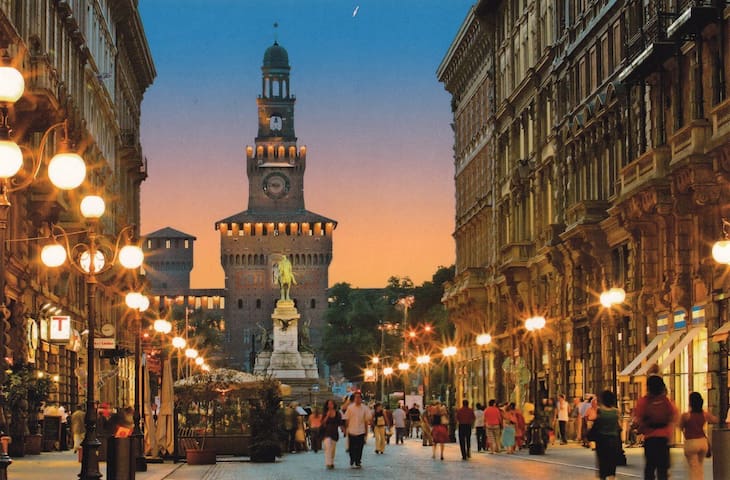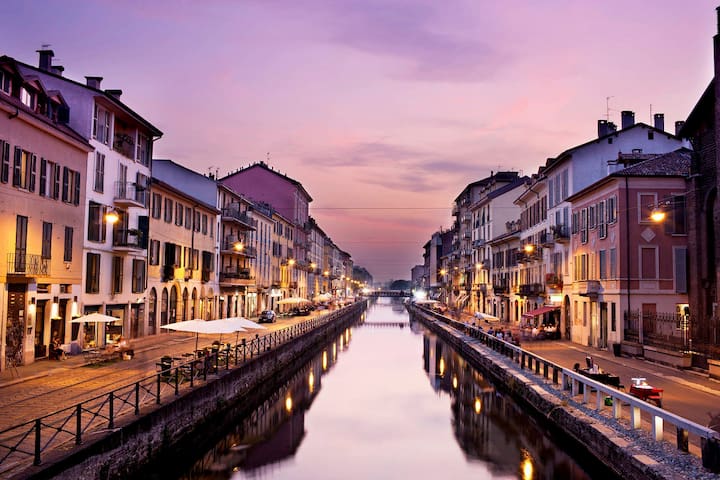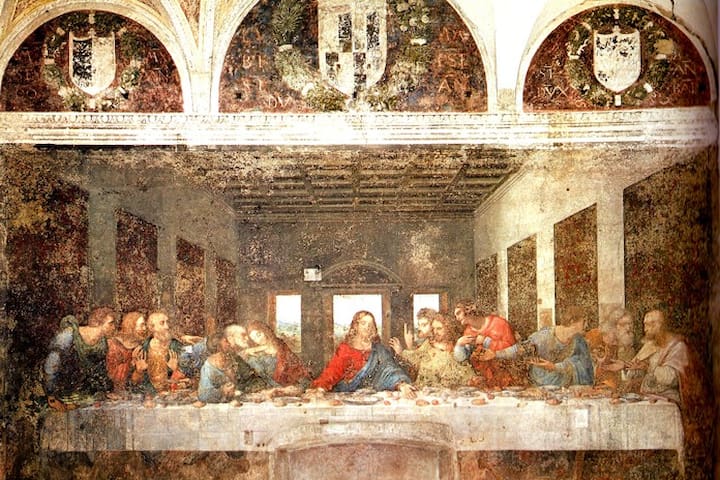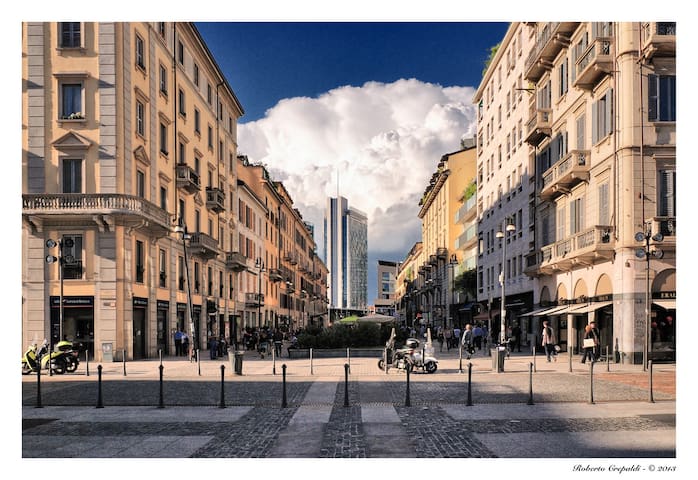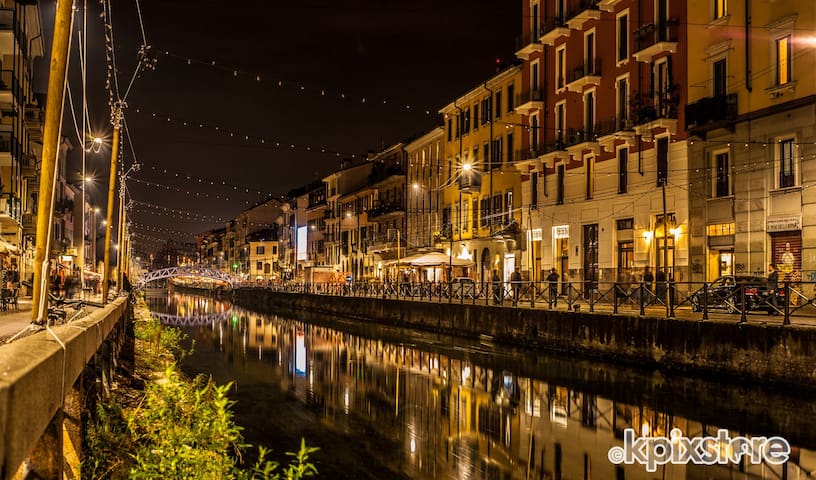Visite turistiche
Located in the heart of Milan, the Duomo is the symbol of this city and enchants visitors with its spiers and its spectacular late-Gothic architectural forms. Its construction began in the second half of the 1300s and was completed around 1800. In 1805, Napoleon Bonaparte was crowned King of Italy in this splendid basilica. Striking from the outside, this wonderful building offers 3,500 statues to admire inside, including those of Primo Carnera and Dante Alighieri. There are 135 spiers and on the largest one, 108.5 meters high, there is the famous Madonnina, a statue about 4 meters high and made of gilded copper. To visit the terraces, from which you can admire a fantastic view over the entire Alpine arc, especially on days when the sky is clear.
2114 Recomendado por los habitantes de la zona
Catedral de Milán
Piazza del DuomoLocated in the heart of Milan, the Duomo is the symbol of this city and enchants visitors with its spiers and its spectacular late-Gothic architectural forms. Its construction began in the second half of the 1300s and was completed around 1800. In 1805, Napoleon Bonaparte was crowned King of Italy in this splendid basilica. Striking from the outside, this wonderful building offers 3,500 statues to admire inside, including those of Primo Carnera and Dante Alighieri. There are 135 spiers and on the largest one, 108.5 meters high, there is the famous Madonnina, a statue about 4 meters high and made of gilded copper. To visit the terraces, from which you can admire a fantastic view over the entire Alpine arc, especially on days when the sky is clear.
Among the places to see absolutely in Milan we find the Sforzesco Castle, located within the suggestive Parco Sempione. Built as a bulwark by Galeazzo II Visconti in the second half of 1300, it owes its name to Francesco Sforza who ordered its construction on the Visconti foundations.
After the unification of Italy, the castle was purchased by the city of Milan who entrusted the restoration to the architect Luca Beltrami. The castle was returned to the city becoming a major attraction for both citizens and tourists. In the castle there is the Museum of Ancient Art, the Furniture Collection, the Picture Gallery, the Collection of Applied Art, the Museum of Musical Instruments, the prehistory and protohistory section, the Egyptian section.
1406 Recomendado por los habitantes de la zona
Castillo Sforza
Piazza CastelloAmong the places to see absolutely in Milan we find the Sforzesco Castle, located within the suggestive Parco Sempione. Built as a bulwark by Galeazzo II Visconti in the second half of 1300, it owes its name to Francesco Sforza who ordered its construction on the Visconti foundations.
After the unification of Italy, the castle was purchased by the city of Milan who entrusted the restoration to the architect Luca Beltrami. The castle was returned to the city becoming a major attraction for both citizens and tourists. In the castle there is the Museum of Ancient Art, the Furniture Collection, the Picture Gallery, the Collection of Applied Art, the Museum of Musical Instruments, the prehistory and protohistory section, the Egyptian section.
Symbol of Milan, the Sempione park is a green lung in the heart of the city, easily reachable by all public transport. Once a parade ground located near the Castello Sforzesco, the park was built at the end of the 19th century, and hosted the first Universal Exhibition in Milan in 1906. Alongside it there are some of the most famous monuments of our city, such as the 'Arco della Pace, the Civic Arena, the Triennale and the Sforzesco Castle. Parco Sempione offers many opportunities for recreation. Nearby there are museums that offer exhibitions of international level.
1487 Recomendado por los habitantes de la zona
Parque Sempione
Piazza SempioneSymbol of Milan, the Sempione park is a green lung in the heart of the city, easily reachable by all public transport. Once a parade ground located near the Castello Sforzesco, the park was built at the end of the 19th century, and hosted the first Universal Exhibition in Milan in 1906. Alongside it there are some of the most famous monuments of our city, such as the 'Arco della Pace, the Civic Arena, the Triennale and the Sforzesco Castle. Parco Sempione offers many opportunities for recreation. Nearby there are museums that offer exhibitions of international level.
Called the living room of the Milanese, the Galleria Vittorio Emanuele is located between Piazza Duomo and Piazza della Scala. Here you can meet travelers, businessmen, but also students and tourists who take a walk inside the gallery to admire the designer shops or to go shopping. There are also many trendy places where you can stop and enjoy an aperitif, a coffee or lunch, immersed in the fascinating setting of this location where the mosaic floor depicts a bull. A curious but fun tradition is to rotate on oneself three times with the right heel pointed at the private parts of the bull to wish each other good luck! The walk on the roofs of the gallery, the Higline Galleria, is beautiful, to observe a unique view of the city from up there!
423 Recomendado por los habitantes de la zona
Galería Vittorio Emanuele II
Piazza del DuomoCalled the living room of the Milanese, the Galleria Vittorio Emanuele is located between Piazza Duomo and Piazza della Scala. Here you can meet travelers, businessmen, but also students and tourists who take a walk inside the gallery to admire the designer shops or to go shopping. There are also many trendy places where you can stop and enjoy an aperitif, a coffee or lunch, immersed in the fascinating setting of this location where the mosaic floor depicts a bull. A curious but fun tradition is to rotate on oneself three times with the right heel pointed at the private parts of the bull to wish each other good luck! The walk on the roofs of the gallery, the Higline Galleria, is beautiful, to observe a unique view of the city from up there!
One of the symbols of Milan, the Teatro della Scala is located in the famous Piazza della Scala, right outside the gallery. It is one of the most famous theaters in the world, unique for its architecture and for the operas that are staged every season. Built following the fire that destroyed the then Ducal Theater, located where the Royal Palace stands today, the Teatro della Scala was built by order of Maria Theresa of Austria who wanted it to be built on the area where the fourteenth-century church of Santa Maria stood of the Scala. Inaugurated on 3 August 1778 with the work "Recognized Europe" by Antonio Salieri, it hosts international premieres in which various illustrious personalities participate.
799 Recomendado por los habitantes de la zona
Teatro alla Scala
2 Via FilodrammaticiOne of the symbols of Milan, the Teatro della Scala is located in the famous Piazza della Scala, right outside the gallery. It is one of the most famous theaters in the world, unique for its architecture and for the operas that are staged every season. Built following the fire that destroyed the then Ducal Theater, located where the Royal Palace stands today, the Teatro della Scala was built by order of Maria Theresa of Austria who wanted it to be built on the area where the fourteenth-century church of Santa Maria stood of the Scala. Inaugurated on 3 August 1778 with the work "Recognized Europe" by Antonio Salieri, it hosts international premieres in which various illustrious personalities participate.
The Navigli district is one of the trendiest and most picturesque in Milan, where the lively spirit coexists with the intimate and quiet atmosphere of its alleys. Easily reachable with the P.ta Genova stop of metro line 2 or with trams 10 and 9, the Navigli area is so called because it includes the Naviglio Grande and the Naviglio Pavese, the system of canals designed by Leonardo da Vinci, on commissioned by Ludovico il Moro (around 1482), to allow navigation from Lake Maggiore to Milan. And return. Even today, the Darsena, where the barges with Candoglia marble once moored to build the Duomo, and all the surroundings, from the ancient wash-houses of the washerwomen to the characteristic railing houses, give the Navigli an ancient charm that contrasts with the lively nightlife. which, every evening, attracts onlookers of all ages, from all over the world
350 Recomendado por los habitantes de la zona
Navigli
The Navigli district is one of the trendiest and most picturesque in Milan, where the lively spirit coexists with the intimate and quiet atmosphere of its alleys. Easily reachable with the P.ta Genova stop of metro line 2 or with trams 10 and 9, the Navigli area is so called because it includes the Naviglio Grande and the Naviglio Pavese, the system of canals designed by Leonardo da Vinci, on commissioned by Ludovico il Moro (around 1482), to allow navigation from Lake Maggiore to Milan. And return. Even today, the Darsena, where the barges with Candoglia marble once moored to build the Duomo, and all the surroundings, from the ancient wash-houses of the washerwomen to the characteristic railing houses, give the Navigli an ancient charm that contrasts with the lively nightlife. which, every evening, attracts onlookers of all ages, from all over the world
n the center of Milan is one of the jewels of the Italian Renaissance: the Basilica of Santa Maria delle Grazie with the adjacent Last Supper.
Due to the presence of the Cenacle, the basilica of Santa Maria delle Grazie was declared a World Heritage Site by Unesco.
Entrance to the Basilica is free every day of the week, at the times indicated
The visit to the Last Supper is strictly regulated to preserve the integrity of the painting (25 people at a time, for 15 minutes). It is necessary to book well in advance.
435 Recomendado por los habitantes de la zona
La Última Cena
2 Piazza di Santa Maria delle Grazien the center of Milan is one of the jewels of the Italian Renaissance: the Basilica of Santa Maria delle Grazie with the adjacent Last Supper.
Due to the presence of the Cenacle, the basilica of Santa Maria delle Grazie was declared a World Heritage Site by Unesco.
Entrance to the Basilica is free every day of the week, at the times indicated
The visit to the Last Supper is strictly regulated to preserve the integrity of the painting (25 people at a time, for 15 minutes). It is necessary to book well in advance.
CityLife is a residential and commercial complex in the Portello district of Milan. It was designed by architects Arata Isozaki, Daniel Libeskind and Zaha Hadid. The neighborhood is also known colloquially as Tre Torri.
270 Recomendado por los habitantes de la zona
City Life
CityLife is a residential and commercial complex in the Portello district of Milan. It was designed by architects Arata Isozaki, Daniel Libeskind and Zaha Hadid. The neighborhood is also known colloquially as Tre Torri.
Symbol of a city projected towards the future, Piazza Gae Aulenti in Milan is the most famous square in the Lombard capital and also the best known in the world after Piazza Duomo. For its innovative technique and environmental protection it was awarded by the Landscape Institute which defined it as one of the most beautiful squares in the world.
An important award, an international recognition arrived in 2016 which certifies the validity of the project. The prize was awarded in the Design for a medium-scale development category.
751 Recomendado por los habitantes de la zona
Plaza Gae Aulenti
1785 Piazza Gae AulentiSymbol of a city projected towards the future, Piazza Gae Aulenti in Milan is the most famous square in the Lombard capital and also the best known in the world after Piazza Duomo. For its innovative technique and environmental protection it was awarded by the Landscape Institute which defined it as one of the most beautiful squares in the world.
An important award, an international recognition arrived in 2016 which certifies the validity of the project. The prize was awarded in the Design for a medium-scale development category.
Offerta gastronomica
One of the most chic and fashionable streets in Milan is certainly Corso Como, a perfect balance of modernity and tradition.
This pedestrian and extremely touristic street connects Piazza XXV Aprile with the Porta Garibaldi station and the nearby Piazza Gae Aulenti, where the Unicredit Tower stands out, which, with its 218 meters high, is the tallest skyscraper in Italy.
709 Recomendado por los habitantes de la zona
Corso Como
Corso ComoOne of the most chic and fashionable streets in Milan is certainly Corso Como, a perfect balance of modernity and tradition.
This pedestrian and extremely touristic street connects Piazza XXV Aprile with the Porta Garibaldi station and the nearby Piazza Gae Aulenti, where the Unicredit Tower stands out, which, with its 218 meters high, is the tallest skyscraper in Italy.
The Navigli district is one of the trendiest and most picturesque in Milan, where the lively spirit coexists with the intimate and quiet atmosphere of its alleys. Easily reachable with the P.ta Genova stop of metro line 2 or with trams 10 and 9, the Navigli area is so called because it includes the Naviglio Grande and the Naviglio Pavese, the system of canals designed by Leonardo da Vinci, on commissioned by Ludovico il Moro (around 1482), to allow navigation from Lake Maggiore to Milan. And return. Even today, the Darsena, where the barges with Candoglia marble once moored to build the Duomo, and all the surroundings, from the ancient wash-houses of the washerwomen to the characteristic railing houses, give the Navigli an ancient charm that contrasts with the lively nightlife. which, every evening, attracts onlookers of all ages, from all over the world.
350 Recomendado por los habitantes de la zona
Navigli
The Navigli district is one of the trendiest and most picturesque in Milan, where the lively spirit coexists with the intimate and quiet atmosphere of its alleys. Easily reachable with the P.ta Genova stop of metro line 2 or with trams 10 and 9, the Navigli area is so called because it includes the Naviglio Grande and the Naviglio Pavese, the system of canals designed by Leonardo da Vinci, on commissioned by Ludovico il Moro (around 1482), to allow navigation from Lake Maggiore to Milan. And return. Even today, the Darsena, where the barges with Candoglia marble once moored to build the Duomo, and all the surroundings, from the ancient wash-houses of the washerwomen to the characteristic railing houses, give the Navigli an ancient charm that contrasts with the lively nightlife. which, every evening, attracts onlookers of all ages, from all over the world.


